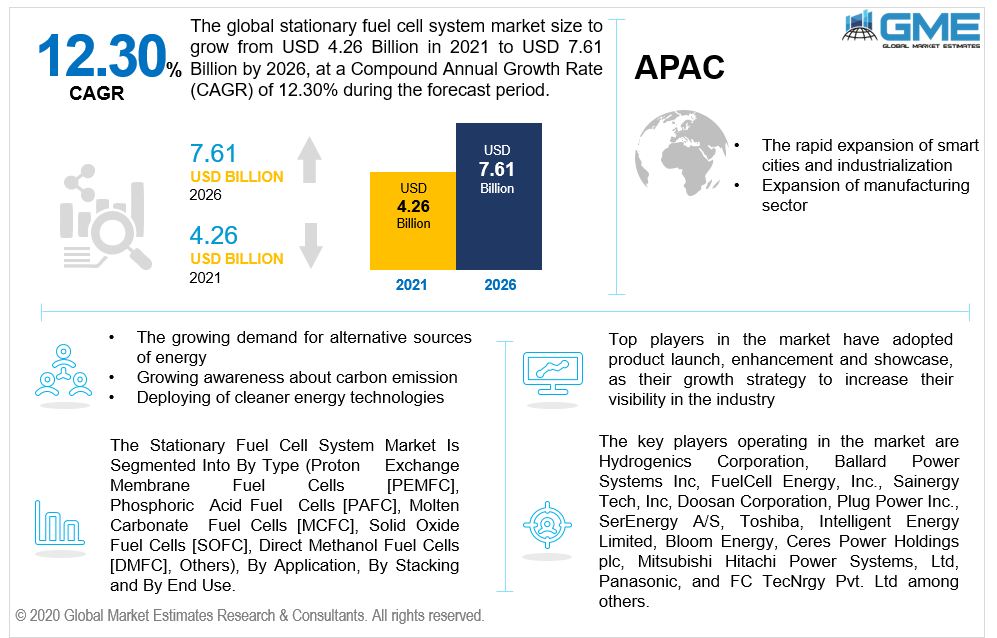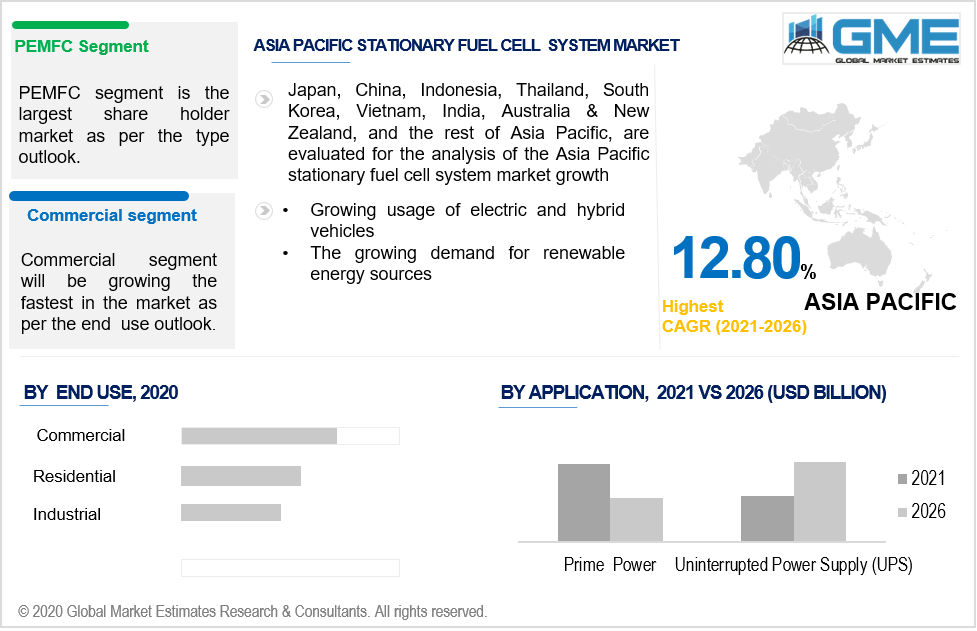
Global Stationary Fuel Cell System Market Size, Trends, and Analysis- Forecasts To 2026 By Type (Proton Exchange Membrane Fuel Cells [PEMFC], Phosphoric Acid Fuel Cells [PAFC], Molten Carbonate Fuel Cells [MCFC], Solid Oxide Fuel Cells [SOFC], Direct Methanol Fuel Cells [DMFC], Others), By Application (Prime Power, Combined Heat And Power (CHP), Uninterrupted Power Supply (Ups), Others), By Stacking (Planar Bipolar Stacking, Stacks With Tubular Cells), By End User (Residential, Commercial, Industrial), By Region (North America, Asia Pacific, CSA, Europe, and the Middle East and Africa); End-User Landscape, Company Market Share Analysis & Competitor Analysis
Fuel cells are used as primary propulsion power or backup source for residential and commercial applications. Stationary fuel cells produce electricity through an electrochemical reaction that is clean, efficient, and reliable. These cells produce less noise and have very low emissions compared to other energy sources. The growing demand for alternative sources of energy, rising awareness about carbon emission, and deploying of cleaner energy technologies are some of the major factors driving the market positively during the forecast period. According to data published by the Fuel Cell & Hydrogen Energy Association, the United States installed approximately 550 megawatts (MW) of stationary fuel cells in 2020. The rapid expansion of smart cities and industrialization are supporting market growth.

Based on the type, the market is divided into direct methanol [DMFC], proton exchange membrane [PEMFC], solid oxide [SOFC], and phosphoric acid [PAFC]. The proton exchange membrane fuel segment will occupy a maximum share in the global market owing to its high efficiency, and low operational cost properties. PEMFC type is the widely preferred fuel cell type in many industries such as automobile, transportation, and telecommunication among others.
Based on the end-user, the market is divided into the commercial and industrial segments. The commercial segment will grow at a higher pace in this market owing to environmental benefits and long-range grid transmissions. The growing demand for renewable and clean energy from the commercial sector is boosting the market growth. The majority of the companies are adopting and installing fuel cells as backup power.

Based on the region, the North American region will lead and occupy a major chunk of the market between the forecast period. The expanding manufacturing sector along with the adoption of advanced and alternative power sources are propelling the market growth. The growing production and usage of electric vehicles and hybrid vehicles in the region also positively impacting market growth. The increasing power generation from cleaner energy sources in developing nations such as China, Japan, and South Korea among others are driving regional growth.
Key players operating in the market include are Hydrogenics Corporation, Ballard Power Systems Inc, FuelCell Energy, Inc., Sainergy Tech, Inc, Doosan Corporation, Plug Power Inc., SerEnergy A/S, Toshiba, Intelligent Energy Limited, Bloom Energy, Ceres Power Holdings plc, Mitsubishi Hitachi Power Systems, Ltd, Panasonic, and FC TecNrgy Pvt. Ltd among others.
Please note: This is not an exhaustive list of companies profiled in the report.
We value your investment and offer free customization with every report to fulfil your exact research needs.
The Global Stationary Fuel Cell System Market has been studied from the year 2019 till 2026. However, the CAGR provided in the report is from the year 2021 to 2026. The research methodology involved three stages: Desk research, Primary research, and Analysis & Output from the entire research process.

The desk research involved a robust background study which meant referring to paid and unpaid databases to understand the market dynamics; mapping contracts from press releases; identifying the key players in the market, studying their product portfolio, competition level, annual reports/SEC filings & investor presentations; and learning the demand and supply side analysis for the Stationary Fuel Cell System Market.

The primary research activity included telephonic conversations with more than 50 tier 1 industry consultants, distributors, and end-use product manufacturers.

Finally, based on the above thorough research process, an in-depth analysis was carried out considering the following aspects: market attractiveness, current & future market trends, market share analysis, SWOT analysis of the companies and customer analytics.

Tailor made solutions just for you
80% of our clients seek made-to-order reports. How do you want us to tailor yours?
OUR CLIENTS